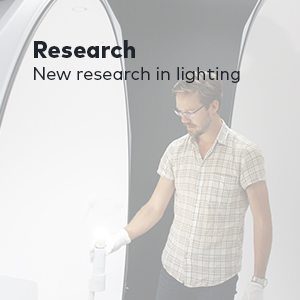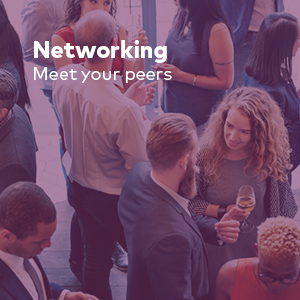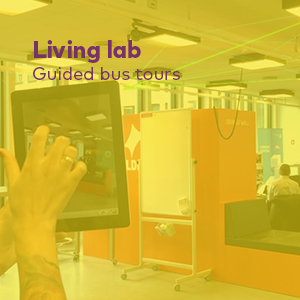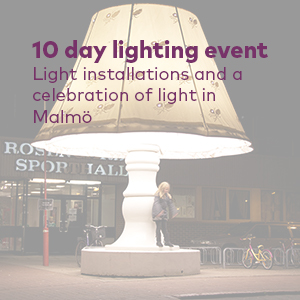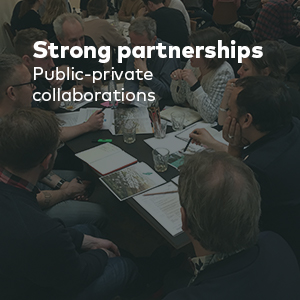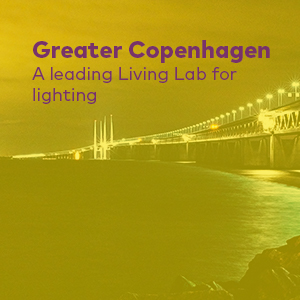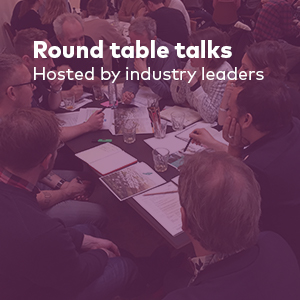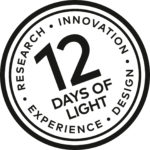We invite you to the city of Malmö as Lighting Metropolis presents Metropolis: by Light. The event will feature a conference at Malmö Live 13 – 14 September, living lab visits on 12 – 15 September and ten days of celebrating innovative urban lighting installations around the city afterwards.
Greater Copenhagen – a brighter region
As the EU-supported project Lighting Metropolis opens its world-leading living lab for smart, urban & human centric lighting in September 2018, a new eco-system for a new era in lighting innovation open up new possibilites both for municipalities, companies, universities and organisations around the globe. Greater Copenhagen is the promoter of a more collaborative, transparent and inclusive spirit to create more liveable cities – and you are invited to join us in 2018 to connect with our diverse range of partners, explore their solutions, get inspired by the visionary industry leaders, learn about the latest findings from the research institutions – and not least celebrate a new era in urban lighting.
The :by Light concept was developed by the city of Malmö, to create an urban platform for innovative lighting solutions that would meet the future demands of our increasingly complex urban scape and its city dwellers.
International conference for innovative lighting
To kick off the whole event, an international conference will showcase innovative lighting solutions – achieved through ground-breaking collaborations across the region – provide cutting edge knowledge and thoughts from industry leaders in keynote seminars on innovative lighting as a means for more liveable cities.
19.00-21.30Conference dinner
| WEDNESDAY 12 SEPTEMBER | |||
| Evening Tours |
Parallel Living Lab Bus Tours – Outdoor Lighting #1 DOLL Living Lab – DOLL in Albertslund is Europe’s largest test field, showroom and innovation hub for intelligent lighting and Smart City solutions #2 Light & Art in Copenhagen – Interactive lighting design at Storm 20, replacement of luminaires with LEDs and visit to Nikolaj Square and Art Gallery #3 Interactive urban lighting – Interactive lighting in public spaces in Roskilde and Egedal #4 Innovative lighting in Lund – Lighting for a smart urban area, safer and more attractive cycling spaces and outdoor lighting for people with visual impairment Details about the Living Lab Tours here. |
||
| THURSDAY 13 SEPTEMBER | |||
| 09.00–09.10 | Welcome speech | ||
| 09.10–09.30 |
Presentation of Lighting Metropolis by Niels Carsten Bluhme Lighting Metropolis is transforming the region into a living lab for lighting with innovative solutions for citizens and major smart lighting demo sites. Universities are collaborating closely with cities and companies. You can gain deeper insight by visiting new solutions in the region and meeting the local experts. |
||
| 09.30–10.15 |
Keynote Florence Lam – Lighting for Humanity Light is fundamental to humanity – from securing safety and resilience and enabling equality to facilitating social interaction and achieving prosperity. Florence’s keynote will offer perspective on how lighting technology and design solutions may contribute to achieving resilience and sustainability. |
||
| 10.15–10.45 | Coffee break | ||
| 10.45–11.30 |
Biological Lighting – effects on health and wellbeing by Ellen Kathrine Hansen, Åsa Moum & Kristina Aggergaard We know the effect that daylight has on humans. Human-centric lighting systems use LED technology and intelligent lighting control systems to match light characteristics that map to humans’ natural circadian rhythms. The intent of these systems is to enhance productivity and performance and to address the psychological and physiological problems that are created by disruptions to our circadian clock. While circadian rhythms are built into the human body, they adapt to the environment using external cues – these cues are primarily daylight. |
||
| 11.30–12.00 |
Keynote Joachim Ritter – Who changed the market? An attempt to gain a perspective of what the future holds for a lighting design specialist What is the future going to look like for those who design lighting – and in fact for the lighting design market as a whole? That is the big question, the answer to which can only be found by taking a “slowly but surely” approach. Change is an ongoing process and the status quo is nothing more than a moment in time. What is causing the current changes we are witnessing, and what experience are the designers gaining, as a result of change? One thing is for sure: we are on the threshold of dramatic changes in our society. And there is no blueprint in place to show us how to deal with the situation. |
||
| 12.00–13.30 | Lunch | ||
| 13.30–14.45 |
Interactive and safety lighting in public spaces by Johan Ib Hansen, Sara Kralmark, Susanna Sonesson, Simon Panduro & Sune Schøning The urban landscape is changing and so must the lighting solutions to keep up. We hope to inspire you all to work with new innovative and interactive light in public spaces. It is all about making people feel part of their city and to let them have fun and share your vision. School crossing: The project Svebølle uses light to connect the school and its activities with the main street of the village. The project is developed together with local businesses and includes data collection, controllable light and interactive installations – used for teaching natural science and mathematics Brighter Brunnshög place branding: Light installations that are self-sufficient energy-wise and encourage visitors to interact and do physical training are a way to draw attention and give identity to a new city district, Brunnshög, in Lund Green alley: To go from A to B sounds easy but sometimes inspirations are needed to get people to use a bike instead of a car or to use a bike helmet etc. With light you can make these choices more natural and appealing. Musicon path: Light in Roskilde that can be changed to make people slow down or even take a detour and that responds to the users and the surroundings. Inspired by the machine industry and hoping to promote bicycling The ZOOper bicycle path: With light and smart technology, we can encourage people to develop new habits in a fun way. It works better than exhortations – for children and adults. In Egedal they worked with the local students for a healthy, safe and fun way to school – while reminding them of using the bicycle helmet |
||
| 14.45–15.15 | Coffee break | ||
| 15.15–16.00 |
Keynote Sandra Rey – The future of lighting. What if nature had the solution? Electrical lighting is responsible for 1.7 billion tons of CO2 every year and 15 percent of global electricity consumption. Meanwhile, more than 80 percent of humans are affected by light pollution. Nature has undertaken 3.8 billion years of R&D to find the most sustainable solutions. Bioluminescent animals might have the sustainable lighting solution we’ve so far overlooked. What if we could grow our own light? |
||
| 16.00 –16.10 | End of sessions | ||
| 18.00-21.30 | Networking, expo and conference dinner | ||
| 21.30 | Guided tour of the :by Light event | ||
| FRIDAY 14 SEPTEMBER | |||
| Friday morning and afternoon you can choose between three parallel activities: Seminars | Round table talks | Bus tours. | |||
| Morning parallel sessions | |||
| 09.00–09.30 |
Keynote Mark Burton-Page – How can we make cities more liveable using lighting? The LUCI network connects cities engaged in using sustainable urban lighting to make cities more liveable. Mark will give examples from cities using light as a tool to create safe, attractive and functional environments. |
#5 Living Lab Tour – Indoor Lighting Biological lighting in psychiatry, elderly care, offices and schools 8.30 – 12.30 |
|
| 09.30–10.15 |
The lighting revolution in Greater Copenhagen – The City by Matthew Nunn In collaboration the City of Copenhagen and Citelum have renewed the street lighting in Copenhagen. Approximately 20.000 luminaires have been replaced and an intelligent communications network has been implemented. |
||
| 10.15–10.45 | Coffee break | ||
| 10.45–11.15 |
Light and Design – the :by Light concept by Johan Moritz Based on four key criteria, selected to engage designers, artists, academics, producers and residents, Malmö’s unique concept goes beyond traditional light events in its ambition to support urban social sustainability. This is the key element in development of public lighting in the city of Malmö. Johan Moritz, City of Malmö/IALD, explains his concept. |
Round table talks – City Lights objects The City Lights objects are intended to provide lighting designers, architects, landscape architects and lighting suppliers with the opportunity to explore new, creative and innovative solutions for lighting public urban environments and to test the “lighting of the future” in a large-scale experiment. Moderator: Bertil Göransson, LUXERA AB, Lighting Designer IALD and Project Manager of lighting object in Metropolis: by LIGHT. Objects: Light Swing, Light Rings by Utskottet AB; Autumn Glow by Fagerhult AB; To the world´s largest Bumling, at the speed of light, The little house on a quite city street by Ateljé Lyktan, WSP and Tyréns; Dark Sky/Bright Night by SWECO10.45 – 12 |
|
| 11.15 –12.00 |
New Research in Lighting by Maria Johansson & Hillevi Hemphälä Outdoor lighting should support visual accessibility, mobility and perceived safety to provide pedestrian-friendly urban environments. The visual environment indoor is essential for our performance. Insufficient light levels can make it hard to read and too much glary light sources can cause headache and eyestrain. This presentation introduces tools to evaluate the visual environment, both indoor and outdoor on new energy-efficient lighting applications. |
||
|
Afternoon parallel sessions |
|||
| 13.30–14.10 |
The lighting revolution in Greater Copenhagen – Research and Education by Michael Mullins A presentation of a selection of initiatives and experiences that help us improve how we use and perceive light in our daily lives. |
Round table talks – Artificial intelligence and disruptive light technologiies in future smart cities
13.30-14.10 |
#6 Living lab tour – Indoor Lighting Lighting for the office, canteen and the neonatal unit 13.30 – 16.30 |
| 14.10 –14.45 |
Public private innovation – A new way of making innovative lighting solutions for the citizens by Jacob Lundgaard & Joakim Nelson Innovation is making a real impact on the lighting industry’s traditional demand-supply chain and its traditional roles. Municipalities are expected to engage in the creative process, while manufacturers are asked to become more open. This paradigm shift requires a radical rethinking of roles and responsibilities. This session presents two proven formulas for accelerating innovation. |
||
| 14.45–15.15 | Coffee break | ||
| 15.15 –15.45 |
Light and Design – The concept of lighting events by Catja Thystrup & Josette Dahlin The growing number of lighting events around the world shows the power of light to inspire and transform the urban spaces around us. Two of Greater Copenhagen’s biggest light events; Dreamlight in Helsingborg and its latest incarnation, Copenhagen Light Festival, offer different takes and perspectives on how light installations and events can increase our cities’ liveability. |
Round table talk – with Mark Major You are invited to participate in a round table talk moderated by Mark Major. Mr. Major will hold a short presentation about a topic 15.15 – 16.30 |
|
| 15.45–16.30 |
New Research in Lighting by Paul Michael Pedersen & Jessika Luth Richter This session discusses how we can move toward better lighting by testing the quality of indoor and outdoor lighting, and reviews the latest research on the environmental impacts of LED lighting products and trade-offs from a lifecycle perspective. |
||
| SATURDAY 15 SEPTEMBER | |||
| 09.30–14.30 |
#7 Living Lab Bus Tour – Indoor & Outdoor Lighting Lighting for the office, canteen, a neonatal unit and safety |
||
Download the programme here
As part of Metropolis: by Light you get the chance to visit some of Lighting Metropolis’ demonstration projects. The Living Lab Bus Tours take you on guided tours to some of the most innovative lighting projects in Greater Copenhagen.
Wednesday 12 September
#1 DOLL Living Lab – Albertslund
Departure from Malmö 18.30 → Arrival in Malmö 22.00
We will visit DOLL Living Lab in Albertslund. It is Europe’s largest test field, showroom and innovation hub for intelligent lighting and Smart City. Here, a 1:1 experience of outdoor lighting is on display.
DOLL supports municipalities, regions and private companies in the development of new and improved lighting solutions. The LED technology can lead to major cost and energy reductions and serve as a framework for future smart city technologies and many more positive outcomes, such as safety.
#2 Art, urban spaces and replacement of luminaires to LED in Copenhagen
Departure from Malmö 18.30 → Arrival in Malmö 22.00
The tour begins at Denmark’s first citizen workshop for history and the arts, Storm 20, where we will see its interactive lighting design. Then we will go by bus and walk through the city centre to observe and hear about the replacement of 20,000 luminaires with LEDs across the city. We will also hear about a new way of using lighting for more secure pedestrian traffic. At the end of the tour we will visit Nikolaj Square and Art Gallery to see how they are creating a new way for audiences to engage with light art in a public space.
#3 Interactive lighting at paths and square & art lighting in Egedal and Roskilde
Departure from Malmö 16.30 → Arrival Malmö 22.00
We will observe intelligent lighting that encourages students to use a bike path instead of the road, plus an innovative LED wall that functions as a digital “speakers corner” at the train station.
In Roskilde we will see the path to the Musicon festival area with innovative and user-activated lighting.
#4 Innovative lighting for a new smart urban area, safer and more attractive biking environments by light installations and outdoor lighting for people with visual impairment in Lund
Departure from Valby (Copenhagen) 18.00, Copenhagen Airport 18.30, Malmö 19.00 → Arrival in Malmö 22.30
The bus picks up participants from “Lysets Dag” in Valby and conference guests arriving at Copenhagen Airport. During the tour, we will visit the new neighbourhood Brighter Brunnshög. The lighting demonstration will help to draw attention to the area as a sustainable and smart neighborhood, and to raise its attractiveness even before settlement is complete. We will also visit a bicycle path featuring a new light installation, installed with the purpose of creating safer and more attractive biking environments through new ways of combining design, technology and social science. Finally, we will hear a presentation about outdoor lighting for people with visual impairment.
Friday 14 September
On Friday you can either participate in the conference or join one of the following bus tours.
#5 Biological lighting in psychiatry, elderly care, office and school in Ballerup and Albertslund
Departure from Malmö 08.30 → Arrival in Malmö 12.30
We will visit the Psychiatric Centre in Ballerup to hear about the effect of biological lighting on the symptoms of eating disorders. Afterwards, we will visit a nursing home in Albertslund where human-centric lighting is used to improve the health of elderly people. Then we will end up at Gate 21 where we will see the office building of the future and hear about light and learning in schools.
#6 Experience energy efficient lighting, biological lighting in office, dynamic light for premature babies/staff/parents at a neonatal ward, canteen lighting for reduced food waste in Lund
Departure from Malmö 13.30 → Arrival in Malmö 16.30
At the beginning of the tour we focus on energy efficient lighting and we will visit an office with human-centric office lighting. We will hear about the development and testing of dynamic lighting solutions for premature babies in a Neonatal ward at Helsingborg General Hospital. The lighting supports the well-being of the patients, their parents and the medical staff. Finally, we will be given a presentation about reducing food waste in school canteens by creating a more welcoming and attractive eating environment.
Saturday 15 September
#7 Human centric office lighting, reduction of flicker in fixtures, canteen lighting for reduced food waste, light in a neonatal ward, safety project in Lund and Helsingborg
Departure from Malmö 09.30 → Arrival in Malmö 14.30
We will visit an office with new human-centric lighting solutions and listen to the evaluations. The results from developing a cost-effective flicker-free driver and investigating the effects flickering has on people will also be presented. We will be informed about how food waste can be reduced by using light that is designed to provide a more positive and calmer eating atmosphere in a school canteen. After lunch we will listen to the development and testing of dynamic lighting solutions for premature babies in a neonatal ward at Helsingborg General Hospital to support the well-being of its patients, their parents and the medical staff. The tour ends with a presentation on how Helsingborg has spotlighted urban problem areas with smart lighting solutions that help people focus on the art, light and sound and help them to feel safer.
Keynote and guest speakers
Florence Lam, Arup Fellow, Director, Global Lighting Designer
Florence is an Arup Fellow and leads Arup’s global lighting design practice. Her expertise in daylight, visual perception and holistic lighting approaches play a key role in many of her projects – from museums to airports, bridges and city precincts. Florence was responsible for delivering a range of lighting projects for the London Olympic Games in 2012. As a lighting designer she has a strong interest in visual light art and has collaborated with various artists and architects on public projects including Anish Kapoor’s ArcelorMittal Orbit in London, the World’s Largest Timepiece in Zurich and Dongdaemun World Design Park in Seoul.
Florence was named Lighting Designer of the Year at the UK Lighting Design Awards in 2013. She was also the recipient of the Lighting Award from the Society of Light and Lighting in 2014.
Joachim Ritter, editor-in-chief, PLD, Head of steering committee, PLDC
Joachim Ritter is a thought leader in the field of international lighting design with 35 years’ professional experience. He specializes in several topics including architecture, lighting design and lighting technology. Joachim is the head of the VIA publishing group and editor-in-chief of the Professional Lighting Design platform. He and his team co- organize international workshops, conferences and other educational activities to promote the lighting design profession. Joachim Ritter was a founding member and fellow of PLDA, plus a member of its board for 15 years, and also served as a member of the board of the IALD Education Trust Fund from 2005 to 2006.
Joachim is currently developing an international CPD platform, targeted at professional lighting designers, which will be launched in August 2018.
Mark Burton-Page, general manager of LUCI
LUCI is the international network of cities for public lighting located in Lyon, France. The network gathers 70 cities around the world, plus 45 associated members, all committed to the sustainable use of light to improve quality of life.
Mark is in charge of the strategy, development and coordination of LUCI’s activities and is the link between the executive board and LUCI staff. His work is focused on the exchange of knowledge and expertise between cities worldwide. This is achieved through the implementation of events, programs and thematic publications. Mark has previously worked for the FFSU and EFUS, shifting attention to prevention and security issues in the context of nightlife and tourism.
He holds a Master’s degree in Political Science.
Mark Major BA (Hons) Dip Arch RIBA FRIAS IALD RDI
Mark Major trained and practised as an architect prior to focusing on the unique relationship between light and architecture. He has worked on a wide range of award-winning lighting projects including the Millennium Dome, 30 St. Mary Axe, Beijing International Airport, the refurbishment of Royal Festival Hall and the re-lighting of the interior of St. Paul’s Cathedral. He is a specialist in the field of urban lighting and was named as a key city advisor by Monocle in 2013. Mark acted as the Lighting Design Advisor to the Olympic Delivery Authority for London 2012 and was appointed to the Mayor of London’s Special Assistance team for the Outer London Fund in the same year. With an active interest in architectural and lighting education Mark has lectured extensively in the UK, Europe, Scandinavia, U.S. and Australia. He was the co-creator of an educational project
‘Made of Light – the Art of Light and Architecture’. Mark is a corporate member of the Royal Institute of British Architects and the International Association of Lighting Designers and a Fellow of the Royal Incorporation of Architects in Scotland. He was created a Royal Designer for Industry in 2012.
Sandra Rey, CEO at Glowee
Sandra is a passionate and dreamy entrepreneur who, following her diploma in industrial design, completed her education with a social entrepreneurship degree.
While gaining professional experience, she has always been surrounded by innovation, leading her to participate in a student contest about synthetic biology where she started to ask herself some questions about the economic and ecological issues surrounding electrical lighting. It was while watching a TV show about deep-sea bioluminescent creatures that she had the idea to use their light-creating super powers to revolutionize the way we illuminate our cities. She keeps a hopeful but realistic view of the mutation of energetic models for tomorrow.
Speakers
Catja Thystrup, Head of Project at the Danish Lighting Center for Copenhagen Light Festival
Catja Thystrup has been working with light from many perspectives; first as an artistic director of Illumenarts, where she curated a series of light festivals, exhibitions and events and designed several lighting installations in public spaces. For several years she worked as a consultant at ÅF Lighting, developing lighting plans for urban and rural areas. Recently, she was the innovation leader for Lighting Metropolis, where she facilitated cross-national collaborations on more than 25 development projects on the future of light. Since October 2017, Catja Thystrup has been Project Manager at the Danish Lighting Center for the Copenhagen Light Festival.
Ellen Kathrine Hansen, associate professor, Aalborg University
Ellen Kathrine Hansen is associate professor at Aalborg University in Copenhagen and director of the Master’s Programme in Lighting Design. Ellen holds a PhD in her main field; transdisciplinary design research and teaching within Lighting Design. Ellen has more than 20 years’ experience driving projects in academia, industry and practice within the field of developing new architectural potentials through the integration of daylight and lighting technology.
Hillevi Hemphälä, PhD, Lund University
Hillevi Hemphälä has a doctoral degree from Lund University, focusing on Visual Ergonomics. She is an optometrist and lighting designer and she studies how to design the visual environment regarding daylight, artificial light sources, computer screens and types of spectacles. Her research areas include visual ergonomic interventions, connections between eyestrain and musculoskeletal discomfort, experience of light, exposure to glare, etc. Her research has covered lighting for postal workers, surgical work and recycling facilities, and she has recently undertaken studies of non-visual flicker from LEDs. She is now studying lighting for neonatal intensive care units.
Jacob Lundgaard, Director of Development, Gate 21
Jacob Lundgaard is Director of Development at Gate 21 in Copenhagen, Denmark. He is a leading Nordic authority on bringing together municipalities, industry and academia to co-create new solutions and knowledge at the frontier of society’s green transition. In recent years he has focused on Smart City possibilities and accelerating change in urban environments through Living Labs.
Jessika Luth Richter, PhD, Lund University
Jessika Luth Richter is a PhD researcher at the International Institute for Industrial Environmental Economics at Lund University. Her research has focused on evaluating EU and national-level policies for lighting, with a particular focus on those related to eco-design, extended producer responsibility and critical materials strategies. Her research has also included life cycle assessments of lighting products to evaluate the trade-offs between different policy objectives related to lighting.
Joakim Nelson, CEO, Innovation Skåne
Joakim Nelson, CEO of Innovation Skåne, has vast experience leading innovation work at an international level with interfaces between business, society and politics. Joakim has previously been active in some of the Skåne region’s most renowned IT companies, as well as the cluster organization Mobile Heights. His broad background provides a great understanding and unique competence when it comes to transforming innovation into action.
Johan Moritz, lighting designer, City of Malmö/IALD
Johan Moritz may be the world’s first lighting designer employed by a municipality. For the past 16 years he has designed prestigious works for Malmö, Sweden’s “art and design-loving city”. In this role, he has had the responsibility of developing Malmö’s architectural lighting design department and has been given complete creative control. With 30 years’ experience, Johan recognizes that sharing knowledge is essential to driving innovation
Josette Dahlin, landscape architect and light designer, City of Helsingborg
Josette Dahlin connects the city of Helsingborg’s visions for a living city centre, security and lighting. In 2018, the third most expensive light festival in the Nordics, “Dreamlight”, was held there for the third time. Here Josette was, once again, creatively responsible for all light installations. Since the first light event at Sofiero in 2003, Josette has been fascinated by events and how to build a sense of a strong visiting community around them. Hear Josette talk about the key to the success of Helsingborg’s festival concept and also about the light festival trends which could be seen at Dreamlight in 2018.
Kristina Aggergaard, project manager, Albertslund Municipality
Kristina Aggergaard has an MSc in Biotechnology and Engineering and is Senior Advisor on Albertslund’s plan to develop IoT and photonics enabling health solutions in close triple helix partnerships with academia and companies. Her focus is on bridging the gap between innovation and care staff, ensuring user involvement and continuous feedback. She has been involved in welfare technology innovation since 2008.
Maria Johansson, Professor, Lund University
Maria Johansson is a professor of environmental psychology at Lund University’s Department of Architecture and Built Environment. Maria’s research area concerns human environment transactions from the individual’s perspective. In particular, the research focuses on environmental qualities including outdoor lighting, in relation to the choice of travel mode and physical activity among adults and children.
Matthew Nunn, CEO, Citelum Denmark A/S
Matthew Nunn, CEO of Citelum Denmark A/S, oversees the Citelum Groups’ activities in Denmark and the wider North Europe zone, where Citelum is active in providing its customers with solutions to their lighting and traffic management needs. Matthew has worked within the EDF Group, Citelum’s parent company, for the last 12 years, first at the UK subsidiary in London, then between 2014 and 2016 he was responsible for building a new electricity supply business for EDF in Poland, based in Warsaw. He moved to Denmark at the beginning of the 2017 to take up his current position. Prior to joining EDF, Matthew worked for the German based energy company, RWE AG. Matthew lives in Hellerup with his wife and two children, and holds a degree in Management from Lancaster University in the UK.
Michael Mullins, associate professor, Aalborg University
Michael Mullins is an Associate Professor at Aalborg University in Copenhagen (AAU). With a background as an architect, he established his own company and has practiced for 20 years before changing to an academic career. Today he is a co-leader of lighting design research at Aalborg University in Copenhagen, and partner in the EU-funded innovation project Lighting Metropolis.
Niels Carsten Bluhme, project director, Albertslund Municipality
Niels Carsten Bluhme is the Chair of the Steering Group of Lighting Metropolis. He has been director in Albertslund Municipality since 2003 – a city leading the environmental charge and active in the green transition and digitization. Niels Carsten Bluhme is the Chair of the Danish Light Innovation Network and has been the representative in the EU DG Connect Photonic Unit Taskforce for SSL, see the report “Lighting up Europe” from 2013. He takes part in steering DOLL, Denmark’s photonic green lab. For 25 years he was partner and CEO of an international consultancy working with construction, environment and energy.
Paul Michael Petersen, professor, Technical University of Denmark
Paul Michael Petersen is full professor in New Light Sources at the Technical University of Denmark. His research focuses on LEDs and diode lasers for medical applications. Paul Michael is also chairman of DOLL – a Photonics Green Lab that tests and develops new lighting technology based on LED technologies.
Sara Kralmark, project manager, Kraftringen
Sara Kralmark is a project manager within business development at the municipally-owned energy company Kraftringen, headquartered in Lund. Her sustainability vision is focused on the new city district Brunnshög, where Kraftringen utilizes industrial heat waste to heat the city, plans large-scale solar power production, installs charging posts for electric vehicles and much more. Sara is a skilled speaker – her presentation at Metropolis: by Light will focus on sustainable lighting.
Simon Panduro Norstedt, lighting designer
Simon started in the project as a student at AAU. Finished his master thesis in the Musicon project in 2017. Now self-employed Lighting Designer and working as a consultant in the project. Simon was a big part of the analyzes phase and the final lighting design on the pumptrack. During the installation Simon has been fine tuning the mounted components and programming the light on the pumptrack.
Sune Shøning, Smart City Coordinator, Egedal Municipality
Sune Schøning works as the Smart City Coordinator in the Municipality of Egedal, and has an MSc in Sustainable Cities. The broad background is useful in applying a sustainable, smart city concept to various fields of the municipality, such as mobility and lighting. Besides that, he is the project leader for the strategic energy planning in municipality. Within his projects, Sune has a high emphasis on using his experience of public engagement in the various projects.
Susanna Sonesson, project manager, Lund Municipality
Susanna Sonesson’s background is as a landscape architect and she has worked on these concerns both as a technical consultant and within the city administration. Her role at the city of Lund is as a project manager for street and traffic planning. Her background has been useful to accomplish all the various parts of the project with all its different exciting new possibilities, from the lighting to how to adapt to the surrounding area.
Åsa Moum, lighting designer, Moum Design
Åsa Moum runs the Stockholm-based lighting design company Moum Design. Starting out with an interest in designing luminaires, delving into control systems, and now creating experiences using light, Åsa stands at the intersection of design, psychology and technology. She studied architectural lighting design and holds an MSc in Computer Science Engineering and a BA in Psychology, for which she completed research on the effect of light on self-control and cognitive performance. Previously she led teams of mechanical engineers and industrial designers to create mobile phone concepts, working in both Sweden and China.
Price
The price for the full event including conference, Living Lab Bus Tours, lunch and the Thursday night conference dinner is
350 EUR
After registering for the event you will receive an invoice from Malmö Stad
Student?
We offer a limited amount of free tickets for students. If you’re interested in joining Metropolis: by Light, please contact Anne Vestrup at anne.vestrup@gate21.dk.
Please note that we will charge a no-show fee of 75 EUR unless you cancel before September 7.
Location
The conference takes place at
Malmö Live
Dag Hammarskjölds Torg 4
211 18 Malmö
Prices:
Single room
12 sept. 1595 SEK
13 sept. 1595 SEK
14 sept. 1095 SEK
Double room:
13 sept. 1795 SEK
14 sept. 1295 SEK
Please note that an administration fee (50 SEK) will be added
Have a look at our program to find out what activities you would like to participate in. When signing up we will need you to inform us about your planned activities.
You can register for Metropolis: by Light here
Are you a student? We welcome you!
If you are a student and interested in joining Metropolis: by Light we offer a limited number of free tickets. All you have to do in order to get your ticket is to write an email to anne.vestrup@gate21.dk.
Don’t hesitate to join the Lighting Revolution



